General
There are about
70 species of butterworts worldwide. Many
are found in
Mexico and in Europe.
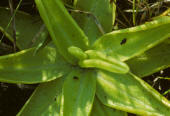 They grow on wet, dripping,
moss-covered rocks in the mountains, on moist, grass-covered
sandy ditches in savannas, and in other similar conditions,
sometimes in company of other carnivorous plants. Of six
species found in the southeastern United States, five are
indigenous to the region. Three other species grow in
northern U.S. and Alaska. They grow on wet, dripping,
moss-covered rocks in the mountains, on moist, grass-covered
sandy ditches in savannas, and in other similar conditions,
sometimes in company of other carnivorous plants. Of six
species found in the southeastern United States, five are
indigenous to the region. Three other species grow in
northern U.S. and Alaska.
Butterworts are a rosette of thin leaves,
typically lying prostrate, with white, fibrous roots. The
upper surface of the leaf is covered with short stalked
glands that secrete clear, sticky mucilage to trap small
animal prey. The leaf feels greasy to the touch because of
this secretions. This gave the plant its common name. The
genus name Pinguicula is derived from the Latin
word pinguis, meaning fat.
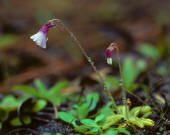 Many butterwort rosettes have close
resemblance to each other, and it is often difficult to
distinguish one species from another when the plants are out
of flower. The leaf is yellowish-green in most species but
has a distinctive reddish color in some species (including
one U.S. species). The diameter of the rosette varies
anywhere from 2 to 15 cm depending on the species. Many butterwort rosettes have close
resemblance to each other, and it is often difficult to
distinguish one species from another when the plants are out
of flower. The leaf is yellowish-green in most species but
has a distinctive reddish color in some species (including
one U.S. species). The diameter of the rosette varies
anywhere from 2 to 15 cm depending on the species.
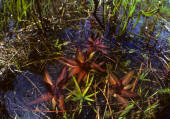
Prey Capture and Digestion
Most of the prey
the butterworts are capable of trapping is small insects such
as gnats, mosquitoes
and small ants. When an insect lands or crawls on
the upper surface of the butterwort's leaf, the insect is mired down to the
surface by the sticky substance secreted by the stalked
glands, as in sundews. Unlike sundew tentacles, however,
these short stalked glands offer no movement. The stalked
gland consists of 16 radiating glandular cells supported on
a single-celled stalk.
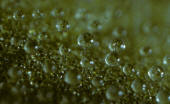 Scattered over
much of the leaf surface
are another kind of glands with a similar structure. These
are sessile (stalkless) glands consisting of 8 radiating
glandular cells. These sessile glands are responsible for the secretions of
digestive fluids and the subsequent absorption of the
products of digestion. Studies have shown that nitrogenous
compounds placed on the leaf surface precipitate the enzyme
secretions from sessile
glands in a matter of minutes. Scattered over
much of the leaf surface
are another kind of glands with a similar structure. These
are sessile (stalkless) glands consisting of 8 radiating
glandular cells. These sessile glands are responsible for the secretions of
digestive fluids and the subsequent absorption of the
products of digestion. Studies have shown that nitrogenous
compounds placed on the leaf surface precipitate the enzyme
secretions from sessile
glands in a matter of minutes.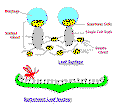
When a small insect -- or any
nitrogenous substance such as a piece of meat -- is placed
on the leaf surface, there is copious secretions of digestive
fluid from the sessile glands. Often a trapped insect
sinks down to the leaf surface -- completely submerged in
the digestive fluids -- and comes
into direct and tight contact with sessile glands on the
leaf surface. The secretions are also shown to contain an
antiseptic substance which effectively prevents bacterial
activities during the course of the digestive process if the
prey is small enough which, in nature, is usually the case.
The resultant digested material is
absorbed through the sessile glands. Studies using
radioactive isotope (carbon 14) show that products of
digestion are rapidly taken into the leaf in a matter of a
few hours and are carried to the other parts of the
plants.
Leaf Movement
Often the leaf movement is observed in
association with the capture of prey. When a small prey is
placed on the leaf surface near the leaf margin, the leaf
begins to curl up.
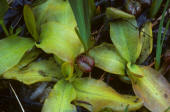 It is a slow motion taking several hours
and possibly lasting several days. Also, the amount of
curling is rather limited. It is unlikely, therefore, that
the leaf movement contributes to the entrapment of the prey
in the same degree as observed in the leaf-folding in some
sundew species.
It is also noted that the contact of an
insect with the leaf (away from the margin) results in the
dishing of the leaf area below the prey. It is a slow motion taking several hours
and possibly lasting several days. Also, the amount of
curling is rather limited. It is unlikely, therefore, that
the leaf movement contributes to the entrapment of the prey
in the same degree as observed in the leaf-folding in some
sundew species.
It is also noted that the contact of an
insect with the leaf (away from the margin) results in the
dishing of the leaf area below the prey.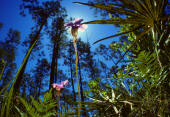
All leaf movements are known to be
caused by the stimulation to the leaf surface and are
attributed to a growth phenomenon. Although not as active as
tentacle bending or leaf folding in sundews, the leaf
movement in butterworts is a matter of common observation.
How much significance should be given
to it is debatable. A general
interpretation is that the upwardly curled leaf
margin -- and localized dishing effect
of the leaf by stimulation
-- help to hold the secretions in place during the digestion
process.
Inflorescence
Butterworts produce a showy
display of colorful flowers which are borne
singly (for most species) at the tip of a
slender, often glandular, pubescent scape. Early spring is
the flowering season for most U.S. species.
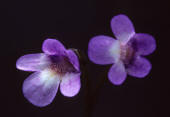 The zygomorphic
(laterally symmetric) flower has a sympetalous (united
petals) corolla forming a cylindrical tube which divides
into five lobes (2 lobes on the upper lip
& 3 on the lower lip) on the front and terminates in a slender
spur on the back. The zygomorphic
(laterally symmetric) flower has a sympetalous (united
petals) corolla forming a cylindrical tube which divides
into five lobes (2 lobes on the upper lip
& 3 on the lower lip) on the front and terminates in a slender
spur on the back.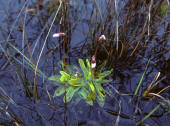 The spur is a nectar
container, a structure commonly seen in insect-pollinating
flowers. Near the lower entrance of the corolla tube
projects a hairy structure known as a palate. The
microscopic structure of the palate hairs, along with the
color and shape of the entire corolla, is characteristic to
each species and can be used for the identification. On the upper side of the inner corolla tube are
located two stamens and a stigma lobe. A wide stigma lobe
covers anthers for incoming pollinators, thus providing a
mechanism to discourage self-pollination. The spur is a nectar
container, a structure commonly seen in insect-pollinating
flowers. Near the lower entrance of the corolla tube
projects a hairy structure known as a palate. The
microscopic structure of the palate hairs, along with the
color and shape of the entire corolla, is characteristic to
each species and can be used for the identification. On the upper side of the inner corolla tube are
located two stamens and a stigma lobe. A wide stigma lobe
covers anthers for incoming pollinators, thus providing a
mechanism to discourage self-pollination.
After the flower, the scape grows
further as it straightens itself. The seeds mature in a
month or so. The seed capsule contains hundreds of tiny,
powder-like seeds. Seeds have a distinctive surface pattern
for each species.
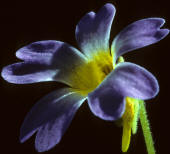
Uses
Apart from the carnivorous nature of
the butterwort plants, people in Scandinavian countries have
mixed the leaf extracts with fresh milk to make it curdle.
|









